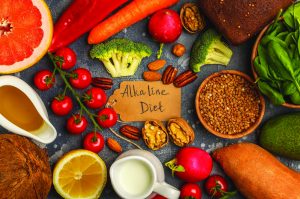 Of late a debate has been going amongst health freaks about the health benefits of the alkaline diets, also known as the alkaline ash diet. Its premise is that your diet can alter the pH value — the measurement of acidity or alkalinity — of your body.
Of late a debate has been going amongst health freaks about the health benefits of the alkaline diets, also known as the alkaline ash diet. Its premise is that your diet can alter the pH value — the measurement of acidity or alkalinity — of your body.
Ross Bridgeford, author of best selling book “The Alkaline Rest Cleanse” says, “your body is amazing and your job is to simply give your body that it needs so that it can repair, rebuild, nourish and thrive”. He claims that his approach is rooted in the science of alkaline balance of body and being healthy and energized is how we are meant to live and feel.
Everything your body needs is found in nature and not in magic pills or potions. There are 400 foods that are alkaline in nature and these foods support the body to maintain its delicate pH balance, while limiting those foods that will have an acid forming effect on the body.
Ross who was regular on TV shows including “What your doctors won’t tell you” says, he has “nothing for sale but the alkaline diet guide is just a gift from me to you”. He suggests that your focus should be on eating leafy vegetables, salads, seeds, nuts and proper hydration. Acidic foods like processed foods, sugar, fast foods, alcohol and glutton containing grains should be a big “No” in your diet.
Joe Leech, an Australian dietitian with a master’s degree in nutrition and dietetics and author of several evidence-based nutrition articles says, “Your metabolism — the conversion of food into energy — is sometimes compared to fire. Both involve a chemical reaction that breaks down a solid mass. However, the chemical reactions in your body happen in a slow and controlled manner. When things burn, an ash residue is left behind. Similarly, the foods you eat leave an ash residue known as metabolic waste. This metabolic waste can be alkaline, neutral, or acidic. The metabolic waste can directly affect your body’s acidity”.
In other words, if you eat foods that leave acidic ash, it makes your blood more acidic. If you eat foods that leave alkaline ash, it makes your blood more alkaline. According to the acid-ash hypothesis, acidic ash is thought to make you vulnerable to illness and disease, whereas alkaline ash is considered protective. By choosing more alkaline foods, you should be able to “alkalize” your body and improve your health.
Food components that leave an acidic ash include protein, phosphate, and sulfur, while alkaline components include calcium, magnesium, and potassium.
Certain food groups are considered acidic, alkaline, or neutral:
Acidic: meat, poultry, fish, dairy, eggs, grains, alcohol
Neutral: natural fats, starches, and sugars
Alkaline: fruits, nuts, legumes, and vegetables
When discussing the alkaline diet, it’s important to understand pH. Put simply, pH is a measurement of how acidic or alkaline something is.
The pH value ranges from 0–14:
Acidic: 0.0–6.9
Neutral: 7.0
Alkaline (or basic): 7.1–14.0
Many proponents of this diet suggest that people monitor the pH of their urine to ensure that it is alkaline (over 7) and not acidic (below 7).
However, it’s important to note that pH varies greatly within your body. While some parts are acidic, others are alkaline — there is no set level. Your stomach is loaded with hydrochloric acid, giving it a pH of 2–3.5, which is highly acidic. This acidity is necessary to break down food. On the other hand, human blood is always slightly alkaline, with a pH of 7.36–7.44. When your blood pH falls out of the normal range, it can be fatal if left untreated. However, this only happens during certain disease states, such as ketoacidosis caused by diabetes, starvation, or alcohol intake.Alkaline foods help in countering the risks of acidity and acid refluxes, bringing some sort of relief. Most traditional Indian meals contain alkaline food items to create a balanced diet.
Acids are basically aqueous solutions that have a pH level of less than 7.0 whereas alkalis have a pH level of more than 7.0, water being the neutral component with a pH of 7.0. In simpler terms, acids are sour in taste and corrosive in nature, whereas alkalis are elements that neutralize acids according to Playaneeta Borah, a food writer by profession and have worked in various publications such as BBC Good Food India, Food Lovers Magazine and Femina, and running her own food blog. In an article on alkaline foods for NDTV, she wrote that during the process of digestion, our stomach secretes gastric acids, which help in breaking down food. The stomach has a pH balance which ranges from 2.0 to 3.5, which is highly acidic but necessary for the process of digestion. However, sometimes, due to unhealthy lifestyle and food habits, the acidic level in the body goes haywire, leading to acidity, acid refluxes and other gastric ailments. If you review the daily diet of most urban dwellers, it contains large amounts of acidic foods such as burger, samosa, pizza, rolls, cheese sandwiches, sausages, bacon, kebabs, colas, doughnuts, pastries, etc – which in the long run can hamper the acidic balance in the stomach.
It is important to note that an ingredient’s acid or alkaline forming tendency in the body has nothing to do with the actual pH of the food itself. Citrus fruits are acidic in nature, but citric acid actually has an alkalizing effect in our body. Alkaline foods are important so as to bring about a balance.
Most traditional Indian meals contain alkaline food items to create a balanced diet. If you have ever tried a typical Assamese lunch, it always starts with a dish called Khar. Khar also refers to the main ingredient in the dish, which is an alkali extracted from the peels of a banana varietal known as Bhim Kol. The peels are dry roasted and preserved, and before preparing the dish, are soaked in warm water to obtain a brownish filtrate which is then used in cooking. The dish can be made with different ingredients, but the one made with raw papaya is most cherished, known as Amitar Khar. If raw papaya isn’t available then cabbage or squash is used as well. Sometimes, a fried fish head is scrambled into the dish during the later stages of the cooking process. Khar is believed to be good for the stomach, easing digestion. If you have been indulging in excessive red meat, processed and junk food, it’s about time you included some alkaline food in your diet like green leafy vegetables, cauliflower and broccoli, capsicum and beans.
Contrary to the belief that citrus fruits are highly acidic and would have an acidic effect on the body, they are the best source of alkaline foods. Lemon, lime and oranges are loaded with Vitamin C and are known to help in detoxifying the system, including providing relief from acidity and heart burn. Seaweed or sea vegetables have 10-12 times more mineral content than those grown on land and are highly alkaline food sources. Root vegetables like sweet potato, taro root, lotus root, beets and carrots are great sources of alkali. Add seasonal fruits in your daily diet as they come packed with vitamins, minerals and antioxidants that take care of various functions in the body- especially kiwi, pineapple, persimmon, nectarine, watermelon, grapefruit, apricots and apples.
Nuts besides being sources of good fats, also produce an alkaline effect in the body. However, since they are high in calories, it is important to have limited quantities of nuts. Include cashews, chestnuts and almonds in your daily meal plan. Among the most important ingredients in Indian cooking, onion, garlic and ginger are great flavour enhancers and are alkaline in nature. Include them in your diet to make the most of their incredible benefit. Give your body what it needs most to repair, rebuild, nourish, thrive and remain energized.
letters@tehelka.com













